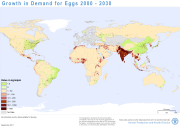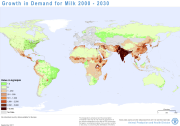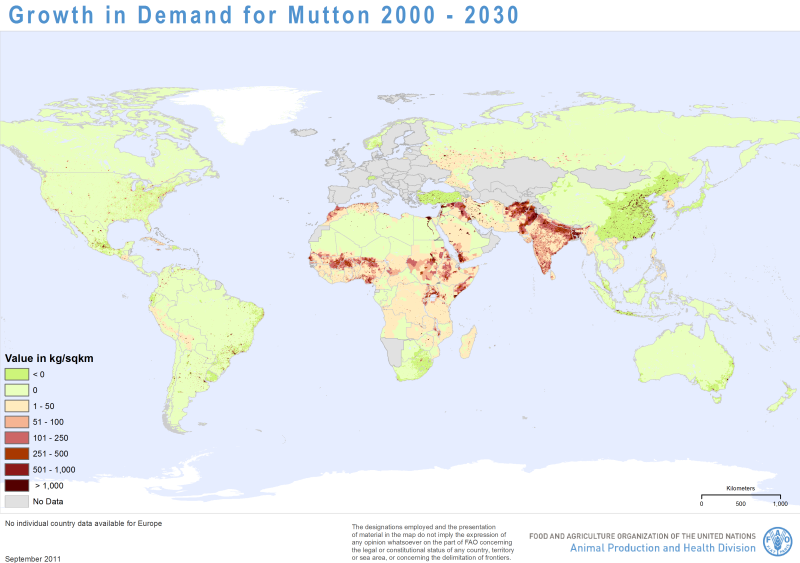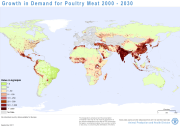unknown
Type of resources
Available actions
Topics
Keywords
Contact for the resource
Provided by
Formats
Representation types
Update frequencies
status
Scale
-

Livestock is one of the fastest-growing sectors in agriculture, potentially presenting opportunities for economic growth and poverty reduction in rural areas. Dealing with the important social, environmental and public health issues linked to sector growth will require solutions that embrace the way in which the livestock sector grows to meet the increasing demand for animal-source foods. It is then important to understand where growth in demand for livestock commodities is likely to occur, and how and where production of livestock commodities will be increased in order to meet it. Estimates of supply and demand for animal-source foods, provided by the Global Perspective Studies Unit at FAO, have been disaggregated spatially for the years 2000 and 2030. Demand for animal-source foods (beef, milk, mutton, pork, poultry meat and eggs) was mapped by estimating per-capita consumption and applying this to mapped population distributions in 2000. Population maps were produced for 2030 based on projected population growth and urbanisation rates and future estimates of per-capita demand applied to these. Similarly, livestock production maps were produced by spatially disaggregating the estimated production based on maps of the relevant livestock species. Methods and results are presented in the forthcoming FAO working paper âMapping Supply and Demand for Animal-Source Foods to 2030 (by T.P. Robinson and F. Pozzi, 2011). Grids and tabular data are distributed here by livestock product and by continent.
-

The Global Urban-Rural Catchment Areas (URCA) is a raster dataset of the 30 urban–rural continuum categories of catchment areas for cities and towns. Each rural pixel is assigned to one defined travel time category: less than one hour, one to two hours, and two to three hours travel time to one of seven urban agglomeration sizes. The agglomerations range from large cities with i) populations greater than 5 million and ii) between 1 to 5 million; intermediate cities with iii) 500,000 to 1 million and iv) 250,000 to 500,000 inhabitants; small cities with populations v) between 100,000 and 250,000 and vi) between 50,000 and 100,000; and vii) towns of between 20,000 and 50,000 people. The remaining pixels that are more than 3 hours away from any urban agglomeration of at least 20,000 people are considered as either hinterland or dispersed towns being that they are not gravitating around any urban agglomeration.
-

Livestock is one of the fastest-growing sectors in agriculture, potentially presenting opportunities for economic growth and poverty reduction in rural areas. Dealing with the important social, environmental and public health issues linked to sector growth will require solutions that embrace the way in which the livestock sector grows to meet the increasing demand for animal-source foods. It is then important to understand where growth in demand for livestock commodities is likely to occur, and how and where production of livestock commodities will be increased in order to meet it. Estimates of supply and demand for animal-source foods, provided by the Global Perspective Studies Unit at FAO, have been disaggregated spatially for the years 2000 and 2030. Demand for animal-source foods (beef, milk, mutton, pork, poultry meat and eggs) was mapped by estimating per-capita consumption and applying this to mapped population distributions in 2000. Population maps were produced for 2030 based on projected population growth and urbanisation rates and future estimates of per-capita demand applied to these. Similarly, livestock production maps were produced by spatially disaggregating the estimated production based on maps of the relevant livestock species. Methods and results are presented in the forthcoming FAO working paper âMapping Supply and Demand for Animal-Source Foods to 2030 (by T.P. Robinson and F. Pozzi, 2011). Grids and tabular data are distributed here by livestock product and by continent.
-

The Land Cover Database of the Islamic Republic of Afghanistan has been created as part of the land cover mapping component of the project on “Strengthening Agricultural Economics, Market Information and Statistics Services” formulated upon request from the Government of the Islamic Republic of Afghanistan and funded by the European Commission. The Food and Agriculture Organization of the United Nations (FAO) provided technical assistance as the executing agency in close cooperation with all parties. The Land Cover database provides information on land cover distribution. It has been created using the FAO/GLCN methodology and tools. The main data sources include satellite imagery from SPOT-4 (2009-2011) and Global Land Survey (GLS-2011) Landsat satellites, high resolution satellite imagery and very hisgh resolution aerial photographs, ancillary data. The national legend was prepared using the Land Cover Classification System (LCCS). FAO’s Mapping Device Change Analysis Tools (MADCAT) software was used to create the database using object based classification methodology. The full resolution land cover legend has 25 classes. As result, more that 500,000 polygons were delineated. To refine the interpretation, high resolution images from various sources are used. The 25 original land cover classes were aggregated into 11 generalized and self-explicative classes as following: Built-Up (URB); Fruit Trees (AGT); Vineyard (AGV); Irrigated Agricultural Land (AGI); Rainfed Agricultural Land (AGR); Forest and Shrubs (NFS); Rangeland (NHS); Barren land (BRS); Sand Cover (BSD); Water Body and Marshland (WAT); Permanent Snow (SNW). The database is distributed in shapefile format in UTM zone 42 North WGS-84 datum. Each shapefile is included in a geodatabase. The tabular attributes contains 4 fields: -AGGCODE is the aggregated class name; -LCCSPERC is the percentage share of each code in the land cover unit as following:100 means that there is only one single land cover class present; 60/40 means that this is a mixed unit land cover class with two classes; the distribution of the land cover classes inside the land cover unit is 60 percent for the first class and 40 percent for the second class; 40/30/30 means that this is a mixed unit land cover class with three classes; the distribution of the land cover classes inside the land cover unit is 40 percent for the first class, 30 percent for the second class and 30 percent for the third class; -DIST_NAME is the second administrative unit level (District level) name based on the administrative layer provided by the Counterpart Agency in Afghanistan; -PROV_NAME is the first administrative unit level (Provincial level) name based on the administrative layer provided by the Counterpart Agency in Afghanistan.
-
Content on the Climate Risk Analysis concept and purpose is needed
-

Livestock is one of the fastest-growing sectors in agriculture, potentially presenting opportunities for economic growth and poverty reduction in rural areas. Dealing with the important social, environmental and public health issues linked to sector growth will require solutions that embrace the way in which the livestock sector grows to meet the increasing demand for animal-source foods. It is then important to understand where growth in demand for livestock commodities is likely to occur, and how and where production of livestock commodities will be increased in order to meet it. Estimates of supply and demand for animal-source foods, provided by the Global Perspective Studies Unit at FAO, have been disaggregated spatially for the years 2000 and 2030. Demand for animal-source foods (beef, milk, mutton, pork, poultry meat and eggs) was mapped by estimating per-capita consumption and applying this to mapped population distributions in 2000. Population maps were produced for 2030 based on projected population growth and urbanisation rates and future estimates of per-capita demand applied to these. Similarly, livestock production maps were produced by spatially disaggregating the estimated production based on maps of the relevant livestock species. Methods and results are presented in the forthcoming FAO working paper âMapping Supply and Demand for Animal-Source Foods to 2030 (by T.P. Robinson and F. Pozzi, 2011). Grids and tabular data are distributed here by livestock product and by continent.
-

The radio censal geographical base was prepared by the Instituto Nacional de Estadística y Censos de la República de Argentina (INDEC), as part of the national geographical units for the National Population, Household and Housing Census 2010 (CNPHyV 2010) al, based on information provided by the Provincial Statistics Offices (DPE). Any administrative boundary of the dataset is accompanied by its code, name, and basic statistical information. The geographical units are territorial subdivisions used to refer statistics. Under this definition there are political divisions (provincias, departamentos, gobiernos locales) and operational statistical units (localidad censal, fracción censal, radio censal). Among them the "radio censal" represents the lowest available spatial unit for aggregated census data in the country. The codes, as unique identification keys, are constructed for each territorial unit from the concatenation of upper level territorial units coding. Using coding system and names it is possible to identify and produce maps for all levels, namely: Level 1 - "División político-territorial" (DPT) - Includes 23 "provincias" and "Ciudad Autónoma de Buenos Aires". Those are identified by two digits. Coding starts with 02, corresponding to the "Ciudad Autónoma de Buenos Aires", and it is incremental in 4 number intervals. Numbering was initially defined by the alphabetical order and units hierarchical level (Capital Federal, provincias y Territorio Nacional de la Tierra del Fuego, Antártida e Islas del Atlántico Sur). The coding is maintained but it does not follow alphabetical order. Coding also contemplates "undetermined" (98) and "unknown” (99) features. Level 2 - "División político-administrativa" (DPA) "Partidos" in Buenos Aires "provincia", "comunas" in "Ciudad Autónoma de Buenos Aires" and "departamentos" in the rest of the "provincias". These political-administrative units are identified by a 5-digit code. Numeric code is formed, from left to right, with two digits from DPT (Level 1) and 3 digits referring to the DPA ("departamento", "partido, "comuna"). For each territorial unit numbering starts with 007 code and is followed in multiples of seven. This order can be changed when a new "departamento" is added or there are changes in areas between "departamentos". Coding includes: "undetermined" (998) and "unknown” (999) features. Level 3/4 - Fracción (level 3) and Radio (Level4) - Are census or statistical units defined by number of households. Each DPA (Level 2) disaggregates in "fracciones" (Level 3) and each of those in "radios" (Level 4). "Fracción" and "Radio" can be urban, rural and mixed type. In urban areas "Fracción" has an average of 5000 households and radio 300, in urban peripheries "radio" can have 200 and in isolated places 100. In rural areas "fracciones" and "radios" are determined by terrain characteristics, accessibility and distance between households. "Fracción" numeric code is formed, from left to right, with two digits corresponding to the Level1 DPT, three digits from Level2 DPA and two more digits representing the "fracción" Level3. "Fracciones" are numbered sequentially, starting with 01 with correlative numbers . "Radio" coding follows the same procedure. Two digits corresponding to the DPT, 3 digits corresponding to the DPA, two digits for Level 3 " fracción" and two more that identify Level 4 "radio". For each "fracción", "radios" are numbered sequentially, starting with 01.
-

The global livestock sector is rapidly changing in response to globalization and growing demand for animal-source foods, driven by population growth and increasing wealth in much of the developing world. As well as the many benefits and opportunities associated with rapid sector transformation and growth, they are also associated with social, environmental and public health risks. There are huge differences in the ways in which livestock are kept in different places and what their roles are. Hence, we need to develop a good understanding of the differences among production systems if we are to be able to help poor livestock keepers take advantage of the rising demand for animal-source foods, help livestock keepers adapt to a changing and more volatile climate; minimize the risk of disease emergence and spread, not only among livestock but also in people; and to help all livestock keepers mitigate greenhouse gas emissions via a wide range of options. The mapping of the Global Livestock Production System is the result of a a long-standing collaboration between FAO and the International Livestock Research Institute (ILRI). The first attempt to map livestock production systems, at least in the developing world, was by Thornton et al. in 2002, based on a classification scheme developed by Seré and Steinfeld in 1996. This version (2011) includes more accurate and higher spatial resolution (circa 1 km) input data and updates the FAO-ILRI previous version. Main reference for this 2011 map is the forthcoming publication of Robinson et al. (2011). This new book provides references to the most up to date map of global livestock production systems and revised estimates of the number of poor livestock keepers, globally, within the different production systems. It proposes alternative approaches to mapping production systems that are explicitly linked to livelihoods, and reviews the ways in which intensive production can be accounted for. The book also underscores the areas that need further development. The FAO and ILRI continue to work jointly on several of these. Data are distributed as ESRI grids.
-

Livestock is one of the fastest-growing sectors in agriculture, potentially presenting opportunities for economic growth and poverty reduction in rural areas. Dealing with the important social, environmental and public health issues linked to sector growth will require solutions that embrace the way in which the livestock sector grows to meet the increasing demand for animal-source foods. It is then important to understand where growth in demand for livestock commodities is likely to occur, and how and where production of livestock commodities will be increased in order to meet it. Estimates of supply and demand for animal-source foods, provided by the Global Perspective Studies Unit at FAO, have been disaggregated spatially for the years 2000 and 2030. Demand for animal-source foods (beef, milk, mutton, pork, poultry meat and eggs) was mapped by estimating per-capita consumption and applying this to mapped population distributions in 2000. Population maps were produced for 2030 based on projected population growth and urbanisation rates and future estimates of per-capita demand applied to these. Similarly, livestock production maps were produced by spatially disaggregating the estimated production based on maps of the relevant livestock species. Methods and results are presented in the forthcoming FAO working paper “Mapping Supply and Demand for Animal-Source Foods to 2030 (by T.P. Robinson and F. Pozzi, 2011). Grids and tabular data are distributed here by livestock product and by continent.
-

Livestock is one of the fastest-growing sectors in agriculture, potentially presenting opportunities for economic growth and poverty reduction in rural areas. Dealing with the important social, environmental and public health issues linked to sector growth will require solutions that embrace the way in which the livestock sector grows to meet the increasing demand for animal-source foods. It is then important to understand where growth in demand for livestock commodities is likely to occur, and how and where production of livestock commodities will be increased in order to meet it. Estimates of supply and demand for animal-source foods, provided by the Global Perspective Studies Unit at FAO, have been disaggregated spatially for the years 2000 and 2030. Demand for animal-source foods (beef, milk, mutton, pork, poultry meat and eggs) was mapped by estimating per-capita consumption and applying this to mapped population distributions in 2000. Population maps were produced for 2030 based on projected population growth and urbanisation rates and future estimates of per-capita demand applied to these. Similarly, livestock production maps were produced by spatially disaggregating the estimated production based on maps of the relevant livestock species. Methods and results are presented in the forthcoming FAO working paper âMapping Supply and Demand for Animal-Source Foods to 2030 (by T.P. Robinson and F. Pozzi, 2011). Grids and tabular data are distributed here by livestock product and by continent.
 FAO Map Catalog
FAO Map Catalog